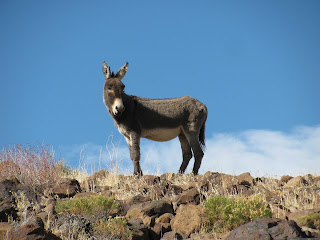For many years, I have had a great interest in the indigenous rock art of the Americas. Perhaps, it comes from growing up in and around the legend of the Piasa Bird, or maybe it's just the parallels I see between the artists wanting to leave a mark on the centuries and my own desire to leave a legacy. Whatever the genesis might be, I recently learned of a Rock Art 101 class being taught by a number of anthropologists from the California Rock Art Foundation. The syllabus included a number of lectures on Saturday followed on Sunday by a rare tour of some of the most dense and artistic rock art of the Coso Range, which is mostly contained within the boundaries of China Lake Naval Air Weapons Station. Of course, I had to jump on this amazing opportunity.
Leaving work on Friday afternoon, I made the six-hour drive to Ridgecrest, CA and got checked into my hotel. The next morning, I awoke early and drove the short distance to the Best Western where the lectures were to be held. During the course of the day, we learned about a number of rock art-related topics, including methods for dating, stylistic differences, the history of the peoples of the Coso Range, determining gender of rock art figures, and finally, an overview of the rock art of the La Rumorosa. The speakers were amazing as they share years of research and their collective insight into the topics covered.
On Sunday, we met near the base before going through a vehicle inspection by the military police (we had previously provided information to facilitate formal background checks) and some rules for our tour, before caravaning the 40-ish miles out into the desert of the dry lake bed of China Lake to Renegade Canyon, also known as Little Petroglyph Canyon.
As our group of about twelve rock art enthusiasts and amateur and professional anthropologists followed our Navy-cleared guides, we were amazed at what were seeing. The canyon itself is only sinks a few feet below the desert floor and winds a length of perhaps three or so miles, but the density of rock art (mostly petroglyphs) is unbelievable. It was difficult to find a surface that had not been turned into an ancient art piece.
Representations of big horn sheep, which are thought to have been a staple of the ancient people's diet are found everywhere in many different styles. Joining the sheep are humanoid figures, medicine bags, deer, dogs, geometric patterns and any number of other elements.
As we make our way down the canyon, the density of the petroglyphs doesn't seem to let up. In places, the canyon walls climb a bit taller and eventually, we are forced to climb down a dry basalt waterfall. It makes for a bit of a challenge for some of my companions, but it's not all that difficult to traverse.
Finally, with the sun starting to grow low in the sky, we decide to turn back. Our guide mentions that while the rock art continues on a bit further down the canyon, we have seen most of it. I would estimate we have encountered 15-20 thousand glyphs to this point - WOW!
The hike wasn't even two miles out-and-back, but the richness of the rock art is beyond belief. Unlike most of my posts, I'm going to post a large number of pictures with this blog, as it's all about the rock art.





























No comments:
Post a Comment